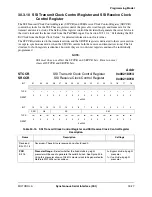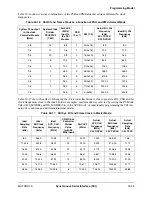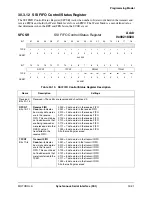
SSI Operating Modes
MOTOROLA
Synchronous Serial Interface (SSI)
30-41
30.5.2 Network Mode
Network mode is used for creating a Time Division Multiplexed (TDM) network, such as a TDM codec
network or a network of DSPs. In continuous clock mode, a frame sync occurs at the beginning of each
frame. In this mode, the frame is divided into more than one time slot. During each time slot, one data
word can be transferred. Each time slot is then assigned to an appropriate codec or DSP on the network.
The DSP can be a master device that controls its own private network, or a slave device that is connected to
an existing TDM network and occupies a few time slots.
The frame sync signal indicates the beginning of a new data frame. Each data frame is divided into time
slots and transmission and/or reception of one data word can occur in each time slot (rather than in just the
frame sync time slot as in normal mode). The frame rate divider, controlled by the DC bits of the STCCR
or SRCCR, selects 2 to 32 time slots per frame.
The length of the frame is determined by the fields of the STCCR or SRCCR registers:
•
The period of the serial bit clock
— for external clocking, this is based on the frequency on the SSI_TXCLK pin
— for internal clocking, this is based on the values of the PSR bit and the PM field
•
The number of bits per sample (WL)
•
The number of time slots per frame (DC)
In network mode, data can be transmitted in any time slot. The distinction of the network mode is that each
time slot is identified with respect to the frame sync (data word time). This time slot identification allows
the option of transmitting data during the time slot by writing to the STX register or ignoring the time slot
by writing to SSI Time Slot Register (STSR). The receiver is treated in the same manner, except that data
is always being shifted into the RXSR and transferred to the SRX register. The MC9328MX1 reads the
SRX register and either uses it or discards it.
30.5.2.1 Network Mode Transmit
The transmit portion of the SSI is enabled when the SSI_EN and the TE bits in the SCSR are both set.
However, for a continuous clock, when the TE bit is set, the transmitter is enabled only after detection of a
new time slot (if the TE bit is set during a slot other than the first). The software must find the start of the
next frame.
The normal start-up sequence for transmission is as follows:
1. Write the data to be transmitted to the STX register. This clears the TDE bit.
2. Set the TE bit to enable the transmitter on the next word boundary (for continuous clock).
3. Enable transmit interrupts.
If the programmer decides not to transmit in a time slot by writing to the SSI Time Slot Register (STSR),
this clears the TDE bit, however the SSI_TXDAT pin remains disabled during the time slot. When the
frame sync is detected or generated (continuous clock), the first enabled data word is transferred from the
STX register to the TXSR and is shifted out (transmitted). When the STX register is empty, the TDE bit is
set. When the TIE bit in the STCR is set, setting the TDE bit causes a transmitter interrupt to occur.
The software can poll the TDE bit or use interrupts to reload the STX register with new data for the next
time slot, or can write to the STSR to prevent transmitting in the next time slot. Failing to write to the STX
register (or the STSR) before the TXSR is finished shifting (empty) causes a transmitter underrun. This is
detected by the TUE bit of the SCSR. When this happens, the SSI_TXDAT pin continuously sends the last
transmitted data.
Summary of Contents for DragonBall MC9328MX1
Page 68: ...1 12 MC9328MX1 Reference Manual MOTOROLA Introduction ...
Page 86: ...2 18 MC9328MX1 Reference Manual MOTOROLA Signal Descriptions and Pin Assignments ...
Page 116: ...3 30 MC9328MX1 Reference Manual MOTOROLA Memory Map ...
Page 126: ...4 10 MC9328MX1 Reference Manual MOTOROLA ARM920T Processor ...
Page 160: ...8 8 MC9328MX1 Reference Manual MOTOROLA System Control ...
Page 272: ...13 32 MC9328MX1 Reference Manual MOTOROLA DMA Controller ...
Page 281: ...Programming Model MOTOROLA Watchdog Timer Module 14 9 ...
Page 282: ...14 10 MC9328MX1 Reference Manual MOTOROLA Watchdog Timer Module ...
Page 300: ...15 18 MC9328MX1 Reference Manual MOTOROLA Analog Signal Processor ASP ...
Page 438: ...18 16 MC9328MX1 Reference Manual MOTOROLA Serial Peripheral Interface Modules SPI 1 and SPI 2 ...
Page 478: ...19 40 MC9328MX1 Reference Manual MOTOROLA LCD Controller ...
Page 574: ...21 32 MC9328MX1 Reference Manual MOTOROLA Memory Stick Host Controller MSHC Module ...
Page 598: ...23 16 MC9328MX1 Reference Manual MOTOROLA Real Time Clock RTC ...
Page 670: ...24 72 MC9328MX1 Reference Manual MOTOROLA SDRAM Memory Controller ...
Page 726: ...25 56 MC9328MX1 Reference Manual MOTOROLA SmartCard Interface Module SIM ...
Page 736: ...26 10 MC9328MX1 Reference Manual MOTOROLA General Purpose Timers ...
Page 854: ...29 18 MC9328MX1 Reference Manual MOTOROLA I2C Module ...
Page 900: ...30 46 MC9328MX1 Reference Manual MOTOROLA Synchronous Serial Interface SSI ...
Page 942: ...32 26 MC9328MX1 Reference Manual MOTOROLA GPIO Module and I O Multiplexer IOMUX ...
















































